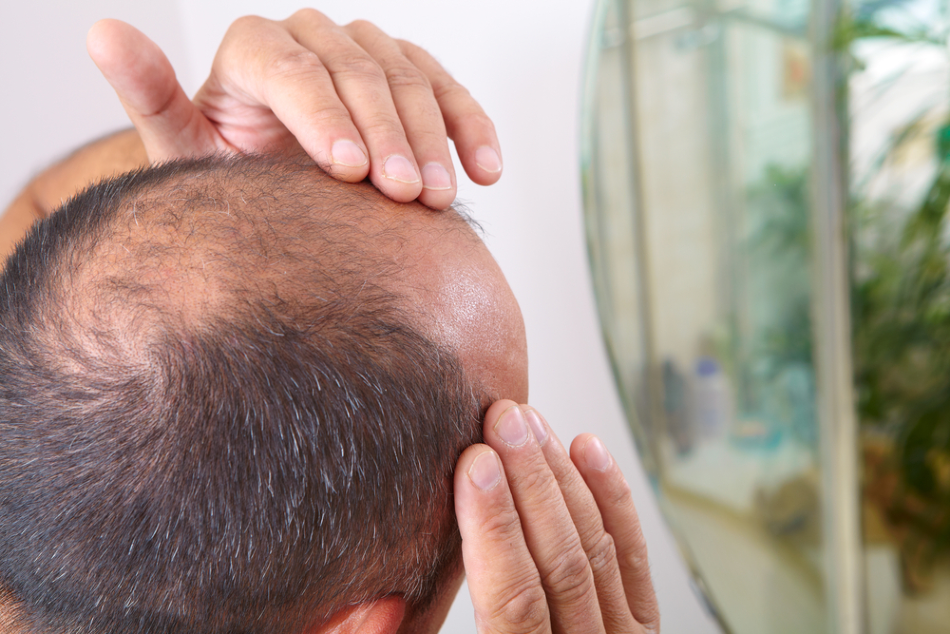Sep 28 2012

Image Credit: docent/Shutterstock.com
Article updated on 24/02/20 by Stephen Edgar
Almost 30% of men over 30 suffer from male pattern baldness, and this percentage is expected to increase to 50% in men over the age of 50. This type of hair loss can be emotional to manage. However, not all men are affected by this problem and some women can also be affected by hair loss, though this typically manifests after menopause due to a lack of estrogen or alopecia areata, which is a condition that causes bald spots or significant hair loss.
Can Hair Loss be Treated?
Hair-loss will occur in men (and women) as a natural consequence of aging. The main FDA approved medication on prescription is Finasteride, a drug that blocks the conversion of testosterone to dihydrotestosterone, slowing or reversing the miniaturization of the hair follicles and to encourage hair growth. New technological interventions for treating hair-loss have appeared with the introduction of laser-based therapy for stimulating hair growth, and robots have also made a ground-breaking contribution to therapy options for hair loss.
Research Developments
The best known surgical hair restoration robot is the ARTAS System and is still the only precision-based robot approved by the FDA for its application in harvesting hair follicles. Even other devices used to aid the surgeon in removing follicles such as the FDA approved Neograft system are reliant on the skill and since these procedures can take many hours, the stamina of the operator.
The ARTAS System is a safe precision robot controlled by a physician, that can move fully-functioning hair follicles and re-establish these hair follicles in the bald regions of a scalp. The repositioning of the new hair follicles moves hair growth to the bald areas to the scalp, reducing the appearance of hair loss, making this possibly the best solution for a long-term intervention to treat hair loss. Because any hair transplantation intervention merely relocates the patients existing hair rather than producing more hair, as many of the harvested follicles must survive the procedure. This is where a robotic system adds value in selecting, removing and transplanting those follicles most likely to survive and doing it optimally thousands of times.
Structural Principle to the ARTAS System
This precision robot uses digital imagery and advanced AI to analyze the condition of the hair follicles on the scalp. The digital scanning of the hair follicles helps select follicles in a randomized pattern and prepares this sample for transplantation. The imaging system allows for a precise movement of the robot across the scalp and works in parallel to a digital visualization embedded system that provides the physician with a 3D display of each hair follicle. The visual serving is a crucial element to the ARTAS System as it allows for the dynamic adjustment of the robot to the patient’s movement.
Functional Principle of the ARTAS System
The main ARTAS procedure involves isolating the area of the scalp that is used to supply the follicular tissue and digitalizes this sample to provide a better view of that particular area on the scalp. With the application of a skin tensioner, the ARTAS robot can isolate the hair follicle and its natural grouping. The ARTAS robot’s proprietary algorithms and digital mapping of the follicular grouping allow the robot to harvest the hair donor and transplant the hair follicles into the bald regions of the scalp.
The only major drawback of using the ARTAS system is that the imaging technology used to identify the follicles for extraction doesn’t work well with light or very curly hair. ARTAS is also limited to certain regions where the hair can be extracted.
ARTAS - Procedure - part 1
The advantage of the ARTAS System is speed and precision providing surgeons with precise control and consistency in results. This robot is also at a distinct advantage when considering reproducibility: with a low transaction rate, grafts are of high quality and this increases the survival rate of the hair grafts. For the patient suffering from long-term hair-loss, the use of a novel precision robot to restore hair is minimally invasive allowing a quick recovery for the patient and a permanent solution to hair loss.
References and Further Reading